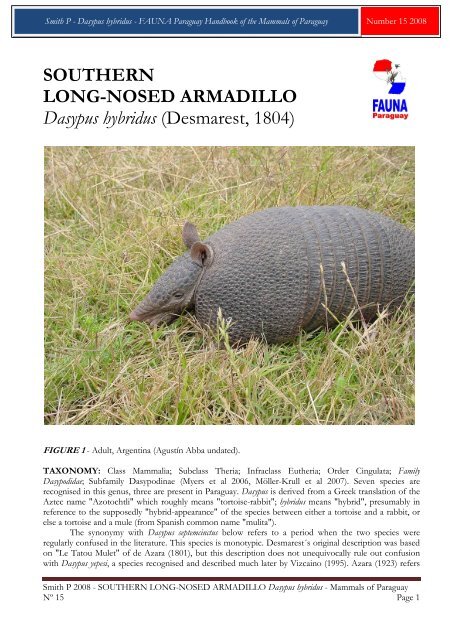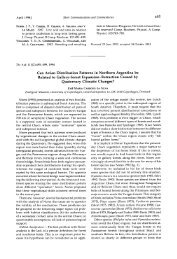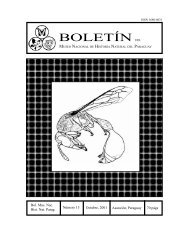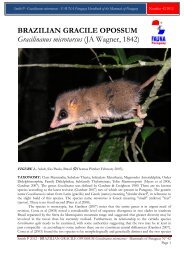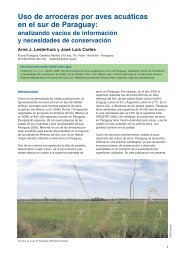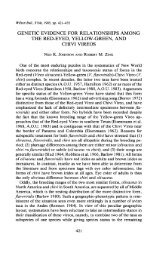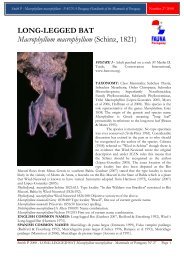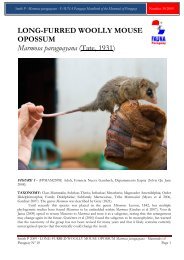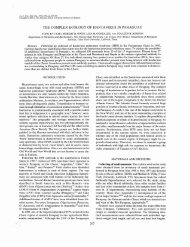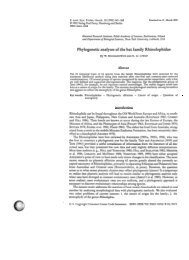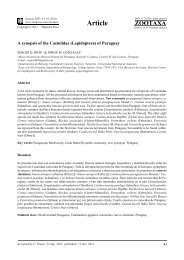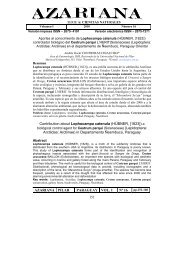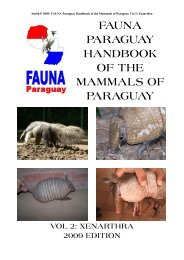Create successful ePaper yourself
Turn your PDF publications into a flip-book with our unique Google optimized e-Paper software.
<strong>Smith</strong> P - Dasypus hybridus - <strong>FAUNA</strong> <strong>Paraguay</strong> Handbook of the Mammals of <strong>Paraguay</strong> Number 15 <strong>2008</strong><br />
SOUTHERN<br />
LONG-NOSED ARMADILLO<br />
Dasypus hybridus (Desmarest, 1804)<br />
FIGURE 1 - Adult, Argentina (Agustín Abba undated).<br />
TAXONOMY: Class Mammalia; Subclass Theria; Infraclass Eutheria; Order Cingulata; Family<br />
Dasypodidae; Subfamily Dasypodinae (Myers et al 2006, Möller-Krull et al 2007). Seven species are<br />
recognised in this genus, three are present in <strong>Paraguay</strong>. Dasypus is derived from a Greek translation of the<br />
Aztec name "Azotochtli" which roughly means "tortoise-rabbit"; hybridus means "hybrid", presumably in<br />
reference to the supposedly "hybrid-appearance" of the species between either a tortoise and a rabbit, or<br />
else a tortoise and a mule (from Spanish common name "mulita").<br />
The synonymy with Dasypus septemcinctus below refers to a period when the two species were<br />
regularly confused in the literature. This species is monotypic. Desmarest´s original description was based<br />
on "Le Tatou Mulet" of de Azara (1801), but this description does not unequivocally rule out confusion<br />
with Dasypus yepesi, a species recognised and described much later by Vizcaino (1995). Azara (1923) refers<br />
<strong>Smith</strong> P <strong>2008</strong> - SOUTHERN LONG-NOSED ARMADILLO Dasypus hybridus - Mammals of <strong>Paraguay</strong><br />
Nº 15 Page 1
<strong>Smith</strong> P - Dasypus hybridus - <strong>FAUNA</strong> <strong>Paraguay</strong> Handbook of the Mammals of <strong>Paraguay</strong> Number 15 <strong>2008</strong><br />
to only two Dasypus armadillos in his treatise, one tatuejo oscuro is clearly Dasypus novemcinctus, the other<br />
tatuejo-mulita has traditionally been associated to this species. The description of tatuejo-mulita refers to no<br />
more than 7 bands and no less than 5, short legs and a vague description of size "no more than 11 inches<br />
without the tail, which reaches six and four". Synonyms adapted from Gardner (2007).<br />
lor[icatus] hybridus Desmarest 1804:28. No type locality given. Based on de Azara (1801). Restricted to San<br />
Ignacio, Misiones, <strong>Paraguay</strong> by Cabrera (1958).<br />
[Dasypus] hybridus G.Fischer 1814:126. Name combination.<br />
[Dasypus] auritus Illiger 1815:108. Nomen nudum.<br />
T[atus] auritus Olfers 1818:221. Type locality "<strong>Paraguay</strong>". Based on de Azara (1801).<br />
Tatusia hybridus Lesson 1827:311. Name combination.<br />
T[atusia] hybrida Turner 1853:213. Corrected gender.<br />
Praopus hybridus Burmeister 1861:428. Name combination.<br />
Tatu hybridus Lahille 1899:203. Name combination.<br />
[Tatusia (Muletia)] hybrida Trouessart 1898:1140. Name combination.<br />
[Tatusia (Muletia)] hybridus Trouessart 1905:814. Name combination.<br />
Muletia hybrida A.Miranda-Ribeiro 1914:46. Name combination.<br />
D[asypus] Brevi-cauda Larrañaga 1923:344. Type locality not given but Uruguay implied. Based on de Azara<br />
(1802).<br />
Dasypus hibridus Azevedo, El Achkar, Martins & Ximénez 1982:95. Incorrect spelling.<br />
ENGLISH COMMON NAMES: Southern Long-nosed Armadillo (Wilson & Cole 2000, Superina &<br />
Aguiar 2006, Gardner 2007), Southern Lesser Long-nosed Armadillo (Redford & Eisenberg 1992).<br />
SPANISH COMMON NAMES: Mulita orejuda (Redford & Eisenberg 1992), Mulita (González 2001),<br />
Mulita pampeana (Chebez 2001), Mulita chica (Chebez 2001). The Spanish name "Mulita" or "little mule"<br />
stems from the long, donkey-like ears present in members of this genus. Despite the name "orejuda"<br />
(meaning big ears) this species has proportionately the shortest ears of the <strong>Paraguay</strong>an Dasypus. "Mulita<br />
chica" (little Mulita) is in direct comparison to the Nine-banded Armadillo, the only Dasypus sympatric<br />
with it over much of its Argentinean range. "Mulita pampeana" reflects its preference for grassland-type<br />
habitats such as those of the Argentinean pampas.<br />
GUARANÍ COMMON NAMES: Tatu mburica MPA (Hamlett 1939). "Tatu mburica" means "Donkey<br />
armadillo" in reference to the long ears of the species.<br />
DESCRIPTION: "Long-nosed" Armadillos have a broad, depressed body, an obtusely-pointed rostrum,<br />
long, pointed ears and short legs. The carapace consists of two immobile plates, the scapular and pelvic<br />
shields separated by 6 or 7 movable bands connected to each other by a fold of hairless skin. The carapace<br />
is mostly dull brownish-grey to brownish-yellow, with a very light covering of hair. Frequently there is a<br />
paler yellowish lateral line that is more visible in some individuals than others and usually reduced to small<br />
triangular "teeth" on that lateral scutes of the movable bands. The scales of the anterior edge of the<br />
movable bands are darker than the rest of the dorsum. Scutes on the movable bands are triangular in<br />
shape, but those on the main plates are rounded. The number of scutes present on the fourth movable<br />
band varies from 50 to 62, with a mean of 54 (Diaz & Barquez 2002, Hamlett 1939). The head is thin and<br />
triangular with a sloping forehead and long, mobile ears with rounded tips that are not separated by<br />
armour at the base. The tail is short compared to other Dasypus (60-70% body length), broad at the base<br />
and narrowing towards the tip. There are four toes on the forefeet (characteristic of the Subfamily<br />
Dasypodinae), the middle two much the longest, and five on the hindfeet. The underside is naked and<br />
pink-grey. Females possess four mammae.<br />
SKELETAL CHARACTERISTICS: Steeply descending frontal bone. Vizcaino et al (1999) give the<br />
following ulnar dimensions (n=6): Ulnar Length 52.9mm (+/-2.7); Olecranon Length 20.6mm (+/-1.2).<br />
The trend towards fossoriality is correlated with relative development of the olecranon process, and the<br />
ratio of the ulnar length to olecranon length is the Index of Fossorial Ability. An IFE above 0.70 is<br />
considered indicative of a highly fossorial species and one below 0.55 of a cursorial species. This species<br />
has an IFE of 0.64 (+/-0.03).<br />
DENTAL CHARACTERISTICS: Armadillos lack true teeth. "Long-nosed" armadillos have singlerooted,<br />
peg-like teeth that lack enamel. Dental formula 6/8=28.<br />
<strong>Smith</strong> P <strong>2008</strong> - SOUTHERN LONG-NOSED ARMADILLO Dasypus hybridus - Mammals of <strong>Paraguay</strong><br />
Nº 15 Page 2
<strong>Smith</strong> P - Dasypus hybridus - <strong>FAUNA</strong> <strong>Paraguay</strong> Handbook of the Mammals of <strong>Paraguay</strong> Number 15 <strong>2008</strong><br />
GENETIC CHARACTERISTICS: 2n=64. FN=76. (Gardner 2007). The SC (synaptonemal complex)<br />
karyotype shows 31 autosomal SCs and the XY pair. The X chromosome is submetacentric and the<br />
extremely acrocentric Y chromosome is one of the two shortest. The absolute length of the Y axis is 4.0<br />
mm (+/-0.8; n=11). The ratio between the X axis and Y axis is X/Y = 4.3 (n=3) in early pachytene. The<br />
length of the XY pair is 4.1 mm (+/-0.6). (Sciurano et al 2003). Redi et al (2005) gives the genome size as<br />
4.89pg (+/-0.34) or 4782 Mbp.<br />
TRACKS AND SIGNS: Dasypus prints can be distinguished from those of other armadillos by their long,<br />
pointed toes with four toes on the forefoot and five on the hindfoot. However they generally leave the<br />
impression of only the two central toes on the forefeet (though sometimes the outer toe is also visible) and<br />
three central toes on the hindfeet. Given a full print, the hindfoot has a pointed heel with three long,<br />
somewhat pointed central toes and two, much shorter, outer toes set well back towards the heel. The<br />
forefoot has the inner toe much reduced and it rarely leaves an impression.<br />
EXTERNAL MEASUREMENTS: The "intermediate" "long-nosed armadillo" in <strong>Paraguay</strong>. TL:<br />
45.95cm (39.7-49.8cm); TA: 16.84cm (13.2-19.1cm); FT: 6.73cm (5.5-7.3cm); EA: 2.51cm (2.3-2.8cm);<br />
WT: 1.5kg (1.09-2.04kg). (Redford & Eisenberg 1992, González 2001). Hamlett (1939) gives the following<br />
mean measurements of preserved specimens for this species Head 7.5cm; Body: 24cm; TA: 15.7cm; EA:<br />
2.33cm (2-3.5cm).<br />
SIMILAR SPECIES: This species is intermediate in size between the other two "long-nosed armadillos"<br />
in <strong>Paraguay</strong> and is characterised by its shorter ears (25-30% of head length) and tail (67-70% of body<br />
length) which give it a distinctive appearance. It can be immediately separated from the much larger and<br />
more widespread Dasypus novemcinctus by the number of bands - 6 or 7 as opposed to eight or nine (usually<br />
8) in that species (Hamlett 1939). Note also that the tail length of D. novemcinctus is equal to or greater than<br />
the body length and that the ears are much longer (40-50% of head length). Dasypus novemcinctus has 7 to 9<br />
teeth in the upper jaw, typically 8, compared to 6 in this species. Using the fourth movable band as a<br />
standard, Hamlett (1939) noted that this species has a mean of 54 scutes whereas D. novemcinctus has a<br />
mean of 60 scutes. Furthermore this species prefers open country habitats, whereas D. novemcinctus is more<br />
often associated with forested areas.<br />
The other open-country Dasypus is the slightly smaller and darker D.septemcinctus, but it is unclear<br />
exactly how much their ranges overlap in <strong>Paraguay</strong> or even if they do at all. D.septemcinctus shares the<br />
number of movable bands and number of teeth in the upper jaw with this species, but is longer-eared (40-<br />
50% head length) and longer tailed (80-100% body length). D.septemcinctus has a mean of 48.4 scutes along<br />
the fourth movable band (Hamlett 1939).<br />
DISTRIBUTION: The most southerly of the Dasypus armadillos, with an extensive range from<br />
Argentina through Uruguay in the east to Brazil, probably as far north as Matto Grosso do Sul. However<br />
the species is apparently absent or un-recorded in many areas of the vast range and the maps given by<br />
Redford & Eisenberg (1992) incorrectly exaggerate the extent of the species distribution in Brazil and<br />
Argentina. In Argentina it is found west only as far as eastern Provincia Cordoba and south to Provincia<br />
Buenos Aires, with records for the Andean foothills being the result of misidentification. Though it has<br />
been cited as present in Provincia Misiones, Argentina there is apparently no confirmation of the species<br />
occurrence there (Chebez 2001) and there are only two records with an imprecise locality from Jujuy both<br />
collected in the 1930s (Diaz & Barquez 2002). In Uruguay it occurs throughout the country and there are<br />
specimen records from all departments except Montevideo. (Daniel Hernández in litt.).<br />
In <strong>Paraguay</strong> the precise range of this species is uncertain because of confusion over the species<br />
identity and a paucity of specimen records. A species of undisturbed grasslands that does not tolerate<br />
human alteration of habitat, its distribution may have been naturally limited in <strong>Paraguay</strong> by the expanse of<br />
the Atlantic Forest and further reduced by human activity. Azara notes that the species does not "pass north<br />
of 26 and a half, but is found to the south" reflecting a more southerly distribution, however today that<br />
represents the area of the country with the greatest conversion of grasslands to agriculture and there are<br />
no modern records from that region. Though the type locality of the species is in <strong>Paraguay</strong>, the only recent<br />
record we are aware of is a male specimen in the Museo Nacional de Historia Natural (MNHNP 3365)<br />
from Estancia Rama III, Departamento Candindeyú, collected on 7 December 2006, this specimen<br />
showing some damage to the tail tip. Neris et al (2001) mapped both this species and that of the Seven-<br />
<strong>Smith</strong> P <strong>2008</strong> - SOUTHERN LONG-NOSED ARMADILLO Dasypus hybridus - Mammals of <strong>Paraguay</strong><br />
Nº 15 Page 3
<strong>Smith</strong> P - Dasypus hybridus - <strong>FAUNA</strong> <strong>Paraguay</strong> Handbook of the Mammals of <strong>Paraguay</strong> Number 15 <strong>2008</strong><br />
banded together, reflecting the lack of clarity in the range of the two species and apparently greatly overestimating<br />
the distribution of both.<br />
HABITAT: This species is typical of native, undisturbed grasslands and is unable to tolerate human<br />
interference, rapidly disappearing from agricultural areas (Edentate Specialist Group 2004, Abba et al<br />
2007). Abba & Cassini (2010) note that they prefer areas with humic soils in Provincia Buenos Aires,<br />
Argentina. Anacleto et al (2006) used the genetic algorithm program GARP to predict the species<br />
distribution in Brazil, with results suggesting this species would occur in Atlantic Forest and Pampas<br />
biomes in that country.<br />
ALIMENTATION: Constantly on the move, this species feeds in much the same way as the Ninebanded<br />
Armadillo, moving rapidly and snuffling constantly when digging shallow foraging holes. In<br />
Uruguay they have been recorded as digging into ant and termite nests. One stomach contained mostly<br />
ants and termites as well as Orthoptera, Lepidoptera, other invertebrates and the remains of a small<br />
rodent, though it is unclear if that individual was hunted or scavenged. (Redford & Eisenberg 1992). Abba<br />
& Cassini (2010) found the species to be strongly myrmecophagous, with almost half the matter in 33 fecal<br />
samples being Formicidae. Leaves, seeds, Coleoptera and Blattaria were less significantly represented. The<br />
food niche breadth was 0.27 on the Levin Index.<br />
Captive individuals were maintained on a daily diet of 100g high protein (26%) commercial puppy<br />
food soaked in water a day before presentation, 50mg powdered milk, water and 30g mince meat. This was<br />
supplemented with vitamins and minerals and an egg was added twice a week.(Ferrari et al 1997).<br />
REPRODUCTIVE BIOLOGY: Ferrari et al (1997) published the first data on captive breeding of the<br />
species. They noted that the breeding cycle begins in March in Buenos Aires with the first copulations,<br />
with births in October and November. The male was not removed from the enclosure as it posed no<br />
threat to the offspring. Embryo counts range from 7 to 12, with 8 the most common number (Redford &<br />
Eisenberg 1992, Adamoli et al 2001).<br />
GENERAL BEHAVIOUR: Solitary and active during the day and at night, though often more<br />
nocturnal in summer to avoid the heat of the day (González 2001). Captive individuals in Buenos Aires,<br />
Argentina were observed to be most active at midday during winter and in the afternoon during summer,<br />
remaining inactive during the hottest temperatures (Ferrari et al 1997).<br />
Abba et al (2009) captured this species mainly during the day in Buenos Aires Province. Abba &<br />
Cassini (2010) found a significant difference in the capture rate of animals outside of their burrows<br />
between the colder seasons (7 captures) and the warmer seasons (34 captures), concluding that the species<br />
is less active in the winter than in the summer, at least in the temperate latitudes that represent the<br />
southern extremes of its range. They speculated that this may be linked to their specialised diet.<br />
Refuges Abba et al (2007) found this species to be specialised in its burrow locations in Provincia<br />
Buenos Aires, Argentina, preferring to locate the burrows in undisturbed grassland habitats.<br />
The main function of burrows is to provide refuge from predators and to provide shelter for<br />
resting (González et al 2001). Burrows are located only in open areas in grasslands and not in forested<br />
habitats. Typically they are around 1-2m long with a single entrance less than 25cm in diameter and dry<br />
grass may be accumulated at the entrance (González 2001). In Uruguay burrows were most frequently<br />
located in open areas with sandy soils on flat or sloping ground (89.3%), in ravines (5.1%) or amongst<br />
rocks (5.6%). (González et al 2001). Of the 20 excavated burrows studied the mean dimensions where<br />
length 118.8cm (+/-105.69cm), width 15.3cm (+/-5.15cm) and depth 43.3cm (+/-10.22cm). These<br />
burrows were approximately cylindrical with a conical end, consisting of a single tunnel without branches<br />
and in 6 cases terminating in a chamber 25.6cm (+/-6.19cm) wide x 35.2cm deep (+/-8.49cm). Burrows<br />
were randomly situated but the entrance avoided facing south, the direction of prevailing winds in the<br />
study area. The considerable difference in burrow lengths may be related to differences in usage. Burrows<br />
providing refuge from predators would be needed year round, and these would be likely to be more<br />
numerous, shorter burrows which are rapidly constructed and fulfil the function of providing safe haven.<br />
The qualities of resting burrows will likely vary through the year given the difference in summer and<br />
winter temperatures in Uruguay. During the cold winters longer and deeper burrows which maintain a<br />
higher temperature than the outside air help the animal thermoregulate. (González et al 2001).<br />
Defensive Behaviour When pursued they run rapidly and erratically towards their burrow.<br />
<strong>Smith</strong> P <strong>2008</strong> - SOUTHERN LONG-NOSED ARMADILLO Dasypus hybridus - Mammals of <strong>Paraguay</strong><br />
Nº 15 Page 4
<strong>Smith</strong> P - Dasypus hybridus - <strong>FAUNA</strong> <strong>Paraguay</strong> Handbook of the Mammals of <strong>Paraguay</strong> Number 15 <strong>2008</strong><br />
Enemies In northeastern Buenos Aires Province, Abba et al (2009) found this species to be<br />
considerably less abundant in areas where dogs where present than in areas where they were absent.<br />
Parasites Navone (1990) recorded the following nematodes in this species in the Argentinean<br />
Pampas: Aspidodera fasciata (Aspidoderidae), Pterygodermatites chaetophracti (Rictularidae) and Mazzia bialata<br />
(Cosmocercidae) and Aspidodera fasciata (Aspidoderidae) in the Espinal region. Pterygodermatites chaetophracti<br />
(Rictularidae) and Mazzia bialata (Cosmocercidae) were also recorded in the Paranaense region. Vicente et<br />
al (1997) list the following nematodes for this species from Brazil in their catalogue: Moennigia lutzi<br />
(Travassos, 1935); Delicata cameroni Travassos, 1935; Macielia macieli (Travassos, 1915) Travassos, 1935.<br />
Ezquiaga et al (<strong>2008</strong>) recorded the flea Tunga penetrans (Siphanoptera) on 7.7% of specimens of this<br />
species captured in northeastern Provincia Buenos Aires. Mauri & Navone (1993) noted Rhophalopsyllus<br />
lutzi cleophontis (Siphanoptera) on this species in Provincia Corrientes.<br />
In the collections they examined Guglielmone et al (2003) noted one Ixodid tick Amblyomma<br />
pseudoconcolor associated with this species. Based on distribution and prevalence in other armadillos they<br />
suggested that Dasypus is not a preferred host for this species. Mauri & Navone (1993) added Androlaelaps<br />
fahrenholzi (Laelapidae) from Provincia Buenos Aires.<br />
Physiology Estecondo & Casanave (2010) describe the morphology of the dorsal surface of the<br />
tongue of this species using a scanning electron microscope and Codón et al (2003) the histology of the<br />
salivary glands. Codón & Casanave (2000) describe the morphology of the ovaries in this species. Ferrari et<br />
al (2000) studied the ultrastructure of the olfactory mucosa of this species in comparison with that of<br />
Chaetophractus villosus.<br />
Cetica et al (2005) described the morphology of the female reproductive tract and found it to have<br />
disk-shaped ovaries with the cortex occupying almost the entire organ and a single oocyte in each follicle.<br />
The uterus was simple and pear-shaped, and the uterine cervix is long as in all armadillos. A urogenital<br />
sinus is present in place of a true vagina. The authors recognised three morphological groups amongst the<br />
Dasypodids studied, with Dasypus armadillos forming their own group amongst the studied genera.<br />
Adamoli et al (2001) described the morphology of the placenta, it being pear-shaped, filling threequarters<br />
of the uterine surface and homogeneously villosus across the maternal face but smooth on the<br />
fetal face where the umbilical cords inserted. No trace of a yolk sac was present. Histological analysis<br />
revealed it to be a hemochorial type placenta.<br />
VOCALISATIONS: Snuffling noises are given when foraging.<br />
HUMAN IMPACT: Hunted throughout its range as a source of food. It is hunted in Uruguay and has<br />
been used in the fabrication of crafts since Prehispanic times, though only during the 20th Century did the<br />
pressure on the species begin to tell (Fallabrino & Castañeira 2006). Abba et al (2007) note that the species<br />
is extremely uncommon in areas close to human populations and in areas where there are domestic dogs.<br />
No specific information is available for <strong>Paraguay</strong> where the species is extremely poorly known, but it is<br />
undoubtedly hunted for food and it is doubtful whether hunters would consciously distinguish this species<br />
from other Dasypus.<br />
CONSERVATION STATUS: The Southern Long-nosed Armadillo is considered Lowest Risk, near<br />
threatened by the IUCN (Abba & Superina 2010), see<br />
http://www.iucnredlist.org/search/details.php/6288/all for the latest assessment of the species. The<br />
Centro de Datos de Conservación in <strong>Paraguay</strong> do not list the species and nor is it listed by CITES. The<br />
species has undergone a decline of at least 10-25% in the last 10 years and is on the verge of being<br />
upgraded to vulnerable. The last conservation assessment of the species in <strong>Paraguay</strong> considered it Least<br />
Concern (Morales 2007), but <strong>Smith</strong> (in press) highlights the limited knowledge of the species´ distribution<br />
in the country and considers it to be data deficient at the national level, with the note that if more was<br />
known about its range it would qualify for a much higher threat category.<br />
This species is more susceptible to human interference than other Dasypus and has<br />
disappeared over large areas of its range in Argentina as a result of the expanse of agriculture. It has<br />
undergone a notable decline and range contraction over the last thirty years as a result of hunting and<br />
habitat destruction and few of the areas with viable populations of the species are under official<br />
protection. Conversion of natural grasslands to agriculture in <strong>Paraguay</strong> has been equally rapid and the<br />
<strong>Smith</strong> P <strong>2008</strong> - SOUTHERN LONG-NOSED ARMADILLO Dasypus hybridus - Mammals of <strong>Paraguay</strong><br />
Nº 15 Page 5
<strong>Smith</strong> P - Dasypus hybridus - <strong>FAUNA</strong> <strong>Paraguay</strong> Handbook of the Mammals of <strong>Paraguay</strong> Number 15 <strong>2008</strong><br />
species has undoubtedly undergone a similarly silent decline in the country. It is considered a conservation<br />
priority in Uruguay (Abba & Superina 2010).<br />
REFERENCES:<br />
Abba AM, Cassini MH <strong>2008</strong> - Los Xenartros (Mamalia: Xenarthra) del Museo Argentino de Ciencias<br />
Naturales Bernardino Rivadavia y del Museo de La Plata (Argentina) - Contribuciones del MACN 4: p5-37.<br />
Abba AM, Cassini MH 2010 - Ecological Differences Between Two Sympatric Species of Armadillos<br />
(Xenarthra, Mammalia) in a Temperate Region of Argentina - Acta Theriologica 55: p35-44.<br />
Abba AM, Superina M 2010 - The 2009/2010 Armadillo Red List Assessment - Edentata 11: p135-184.<br />
Abba AM, Vizcaino SF, Cassini SH 2007 - Effects of Land Use on the Distribution of Three Species of<br />
Armadillos in the Argentinean Pampas - Journal of Mammalogy 88: p502-507.<br />
Abba AM, Vizcaíno SF, Cassini MH 2009 - Eto-Ecología y Conservación de Tres Especies de<br />
Armadillos (Dasypus hybridus, Chaetophractus villosus y C.vellerosus) en el Noreste de la Provincia de Buenos<br />
Aires, Argentina - Edentata 8-10: p41-47.<br />
Adamoli VC, Cetica PD, Merani MS, Solari AJ 2001 - Comparative Morphologic Placental Types in<br />
Dasypodidae (Chaetophractus villosus, Cabassous chacoensis, Tolypeutes matacus and Dasypus hybridus) - Biocell 25:<br />
p17-22.<br />
Anacleto TCS, Diniz-Filho JAF, Vital MVC 2006 - Estimating Potential Geographic Ranges of<br />
Armadillos (Xenarthra, Dasypodidae) in Brazil Under Niche-based Models - Mammalia 70: p202-213.<br />
Azara F de 1801 - Essais sur l´Histoire Naturelle des Quadrupèdes de la Province du <strong>Paraguay</strong> - Charles<br />
Pougens, Paris.<br />
Azara F de 1802 - Apuntamientos para la Historia Natural de los Quadrúpedos del <strong>Paraguay</strong> y Rio de la<br />
Plata - La Imprenta de la Viuda de Ibarra, Madrid.<br />
Azara F de 1923 - Viajes por la America Meridional - Calpe, Madrid.<br />
Azevedo TR de, El Achkar D, Martins M de, Ximénez A 1982 - Lista Sistemática dos Mamíferos de<br />
Santa Catarina Conservados nos Principais Museus do Estado - Revista Nordest. Biol. 5: p93-104.<br />
Burmeister H 1861 - Reise Durch die La Plata-Staaten, mit Besonderer Rücksicht auf die Physische<br />
Beschaffenheit und den Culturzustand der Argentinischen Republik Ausgeführt in den Jahren 1857, 1858,<br />
1859 und 1860 - HW Schmidt, Halle.<br />
Cabrera A 1958 - Catálogo de los Mamíferos de América del Sur - Revista Museo Aregntino de Ciencias<br />
Naturales Bernadino Rivadavia Zoology 4: p1-307.<br />
Cetica PD, Marcos HJA, Merani MS 2005 - Morphology of Female Genital Tracts in Dasypodidae<br />
(Xenarthra: Mammalia): A Comparative Survey - Zoomorphology 124: p57-65.<br />
Chebez JC 2001 - Fauna Misionera - LOLA, Buenos Aires.<br />
Cimari AV 1996 - Mamíferos de Santa Catarina - FATMA, Florianópolis.<br />
Codón SM, Casanave EB 2000 - Comparative Morphology of the Ovaries of Three Species of<br />
Dasypodidae (Mammalia, Xenarthra) - Revista Chilena de Anatomía 18: p251-257.<br />
Codón SM, Estecondo S, Casanave EB 2003 - Histological Study of the Salivary Glands in Dasypus<br />
hybridus (Mammalia, Dasypodidae) - International Journal of Morphology 21: p199-204.<br />
Desmarest AG 1804 - Tableau Méthodique des Mammifères in Nouveau Dictionnaire d´Histoire<br />
Naturelle, Appliquée aux Arts, Principalement à l`Agriculture, à l`Économie Rurale et Domestique: Par<br />
une Société de Naturalistes et d`Agriculteurs: Avec des Figures Tirées des Trois Règnes de la Nature -<br />
Deterville Vol 24, Paris.<br />
Díaz MM, Barquez RM 2002 - Los Mamíferos del Jujuy, Argentina - LOLA, Buenos Aires.<br />
Edentate Specialist Group 2004 - The 2004 Edentate Species Assessment Workshop - Edentata 6: p1-26.<br />
Estecondo S, Casanave EB 2010 - Scanning Electron Microscopy Study of the Dorsal Surface of the<br />
Tongue in Dasypus hybridus (Mammalia, Xenarthra, Dasypodidae) - International Journal of Morphology 28:<br />
p379-384.<br />
Ezquiaga MC, Lareschi M, Abba AM, Navone GT <strong>2008</strong> - Nuevos Registros de Pulgas (Siphonaptera)<br />
Parásitas de Dasipódidos (Mammalia: Xenarthra) en el Noroeste de la Provincia de Buenos Aires,<br />
Argentina - Mastozoologia Neotropical 15: 193-196.<br />
Fallabrino A, Castañeira E 2006 - Situación de los Edentados en Uruguay - Edentata 7: p1-3.<br />
<strong>Smith</strong> P <strong>2008</strong> - SOUTHERN LONG-NOSED ARMADILLO Dasypus hybridus - Mammals of <strong>Paraguay</strong><br />
Nº 15 Page 6
<strong>Smith</strong> P - Dasypus hybridus - <strong>FAUNA</strong> <strong>Paraguay</strong> Handbook of the Mammals of <strong>Paraguay</strong> Number 15 <strong>2008</strong><br />
Ferrari CC, Carmanchahi PD, Aldana Marcos HJ, Affanni JM 2000 - Ultrastructural Characterisation<br />
of the Olfactory Mucosa of the Armadillo Dasypus hybridus (Dasypodidae, Xenarthra) - Journal of Anatomy<br />
196: p269-278.<br />
Ferrari CC, Carmanchahi PD, Bolkovic ML, Affanni JM 1997 - Breeding in Captivity of the Southern<br />
Lesser Long-nosed Armadillo Dasypus hybridus - Zoocriaderos 2: p1-5.<br />
Fischer G 1814 - Zoognosia Tabulis Synopticis Illustrata: Volumen Tertium. Quadrupedum Reliquorum,<br />
Cetorum et Monotrymatum Descriptionen Continens - Nicolai Sergeidis Vsevolozsky, Mosquae.<br />
Gardner AL 2007 - Mammals of South America Volume 1: Marsupials, Xenarthrans, Shrews and Bats -<br />
University of Chicago Press.<br />
González EM 2001 - Guía de Campo de los Mamíferos de Uruguay: Introducción al Estudio de los<br />
Mamíferos - Vida Silvestre, Montevideo.<br />
González EM, Soutollo A, Altuna CA 2001 - The Burrow of Dasypus hybridus (Cingulata: Dasypodidae) -<br />
Acta Theriologica 46: p53-59.<br />
Guglielmone AA, Estrada-Peña A, Luciani CA, Mangold AJ, Keirans JE 2003 - Hosts and<br />
Distribution of Amblyomma auricularium (Conil 1878) and Amblyomma pseudoconcolor Argaão, 1908 (Acari:<br />
Ixodidae) - Experimental and Applied Acarolgy 29: p131-139.<br />
Hamlett GWD 1939 - Identity of Dasypus septemcinctus Linnaeus with Notes on Some Related Species -<br />
Journal of Mammalogy 20: p328-336.<br />
Illiger JKW 1815 - Ueberblick der Säugthiere nach Ihrer Vertheilung Über die Welttheile - Abhandl. König.<br />
Akad. Wiss. Berlin 1804-18811: p39-159.<br />
Lahille F 1899 - Essayo Sobre la Distribución Geográfica de los Mamíferos en la República Argentina<br />
p165-206 in Bery C, Bahía MB, Reyes FB eds Trabajos de la Segunda Sección (Ciencias Físico-Químicas y<br />
Naturales), Primero Reunión del Congreso Científico Latino Americano - Sociedad Científica Argentina,<br />
Buenos Aires.<br />
Larrañaga DA 1923 - Escritos - Instituto Histórico y Geográfico del Uruguay, Montevideo.<br />
Lesson RP 1827 - Manuel de Mammalogie ou Histoire Naturelle des Mammifères - Roret, Paris.<br />
Mauri R, Navone GT 1993 - Ectoparásitos (Siphanoptera y Acari) más Comunes en Dasypodidae<br />
(Mammalia: Xenarthra) de la Republica Argentina - Revista de la Sociedad Entomológica de Argentina 52: p121-<br />
122.<br />
Mirando-Ribeiro A 1914 - Mamíferos- Cebidae, Hapalidae, Vespertilionidae, Emballonuridae,<br />
Phyllostomatidae, Felidae, Mustelidae, Canidae, Procyonidae, Tapyridae, Suidae, Cervidae, Sciuridae,<br />
Muridae, Octodontidae, Coenduidae, Dasyproctidae, Caviidae e Leporidae; Platanistidae; Bradypodidae,<br />
Myrmecophagidae, Dasypodidae, Didelphyidae - Comissão de Linhas Telegraphicas Estrategicas de Matto-<br />
Grosso ao Amazonas, Annexo 5.<br />
Möller-Krull M, Delsuc F, Churakov G, Marker C, Superina M, Brosius J, Douzery EJP, Schmitz J<br />
2007 - Retroposed Elements and Their Flanking Regions Resolve the Evolutionary History of Xenarthran<br />
Mammals (Armadillos, Anteaters and Sloths) - Molecular Biology and Evolution 24: p2573-2582<br />
Morales MA 2007 - Diversidad de Mamíferos en <strong>Paraguay</strong>. Pp. 133–149 in: Biodiversidad del <strong>Paraguay</strong>,<br />
Una Aproximación a sus Realidades (D.A. Salas-Dueñas and J.F. Facetti, eds.) - Fundación Moises<br />
Bertoni, USAID, GEF/BM, Asunción, <strong>Paraguay</strong>.<br />
Myers P, Espinosa R, Parr CS, Jones T, Hammond GS, Dewey A 2006 - The Animal Diversity Web<br />
(online). Accessed July <strong>2008</strong>.<br />
Navone GT 1990 - Estudio de la Distribución, Porcentaje y Microecología de los Parásitos de Algunas<br />
Especies de Edentados Argentinos - Studies in Neotropical Fauna and Environment 25: p199-210.<br />
Neris N, Colman F, Ovelar E, Sukigara N, Ishii N 2002 - Guía de Mamíferos Medianos y Grandes del<br />
<strong>Paraguay</strong>: Distribución, Tendencia Poblacional y Utilización - SEAM, Asunción.<br />
Nowak RM 1991 - Walker´s Mammals of the World 5th Ed Volume 1 - Johns Hopkins, Baltimore.<br />
Olfers I 1818 - Bemerkungen zu Illiger´s Ueberblick der Säugthiere, nach Ihrer Vertheilung über die<br />
Welttheile, Rücksichtlich der Südamerikanischen Arten p192-237 in Bertuch FI Neue Bibliothek der<br />
Wichtigsten Reisebeschreibungen zue Erweiterung der Erd - und Völkerkunde; in Verbindung mit Einigen<br />
Anderen Gelehrten Gesammelt und Herausgegeben - Verlage des Landes-Industrie-Comptoirs, Weimar.<br />
<strong>Smith</strong> P <strong>2008</strong> - SOUTHERN LONG-NOSED ARMADILLO Dasypus hybridus - Mammals of <strong>Paraguay</strong><br />
Nº 15 Page 7
<strong>Smith</strong> P - Dasypus hybridus - <strong>FAUNA</strong> <strong>Paraguay</strong> Handbook of the Mammals of <strong>Paraguay</strong> Number 15 <strong>2008</strong><br />
Redford KH, Eisenberg JF 1992 - Mammals of the Neotropics: Volume 2 The Southern Cone -<br />
University of Chicago Press, Chicago.<br />
Redi CA, Zacharias H, Merani S, Oliveira-Miranda M, Aguilera M, Zuccotti M, Garagna S,<br />
Capanna E 2005 - Genome Sizes in Afrotheria, Xenarthra, Euarchontoglires and Laurasiatheria - Journal<br />
of Heredity 96: p485-493.<br />
Sciurano RB, Merani M, Bustos J, Solari AJ 2006 - Synaptonemal Complexes and XY Behavior in Two<br />
Argentinian Armadillos: Chaetophractus villosus and Dasypus hybridus (Xenarthra, Dasypodidae) - Biocell 30:<br />
p57-66.<br />
<strong>Smith</strong> P (in press) - Assessing the Assessment, the Relevance of the 2006 <strong>Paraguay</strong>an Mammal<br />
Conservation Assessment to the Reality of Xenarthran Conservation in 2012 - Edentata.<br />
Superina M, Aguiar JM 2006 - A Reference List of Common Names for the Edentates - Edentata 6: p33-<br />
44.<br />
Trouessart EL 1898 - Catalogus Mammalium tam Viventium quam Fossilium. Fasciculus V: Sirenia,<br />
Cetacea, Edentata, Marsupialia, Allotheria, Monotremata - R.Friedländer & Sohn, Berolini.<br />
Trouessart EL 1905 - Catalogus Mammalium tam Viventium quam Fossilium. Quinquennale<br />
Supplementium (1899-1904) Cetacea, Edentata, Marsupialia, Allotheria, Monotremata Index Alpabeticus -<br />
R.Friedländer & Sohn, Berolini.<br />
Turner HN Jr 1853 - On the Arrangement of the Edentate Mammalia - Proceedings of Zoological Society of<br />
London 1851: p205-221.<br />
Vicente JJ, Rodrigues H de O, Gomes DC, Pinto RM 1997 - Nematóides do Brasil Parte V:<br />
Nematóides do Mamíferos - Revista Brasileira de Zoologia 14 Supp 1: p1-452.<br />
Vizacaino SF 1995 - Identificación de las "Mulitas" Genero Dasypus (Mammalia: Dasypodidae) del<br />
Noroeste Argentino. Descripción de una Nueva Especie - Mastozoología Neotropical 2: p5-13.<br />
Vizcaíno SF, Fariña RA, Mazzetta GV 1999 - Ulnar Dimensions and Fossoriality in Armadillos - Acta<br />
Theriologica 44: p309-320.<br />
Wilson DE, Cole FR 2000 - Common Names of Mammals of the World - <strong>Smith</strong>sonian Institution Press,<br />
Washington and London.<br />
CITATION: <strong>Smith</strong> P <strong>2008</strong> - <strong>FAUNA</strong> <strong>Paraguay</strong> Handbook of the Mammals of <strong>Paraguay</strong> Number 15<br />
Dasypus hybridus - www.faunaparaguay.com/dashybhb.html.<br />
FIGURE 2 - Southern Long-nosed Armadillo Dasypus hybridus.<br />
Head detail. Argentina, undated. Photo Agustín Abba.<br />
FIGURE 3 - (FPMAM77PH) Southern Long-nosed Armadillo Dasypus hybridus.<br />
In hand. Estancia La Rama III, Departamento Canindeyú. Photo Centro de Mastozoologia del <strong>Paraguay</strong>.<br />
<strong>Smith</strong> P <strong>2008</strong> - SOUTHERN LONG-NOSED ARMADILLO Dasypus hybridus - Mammals of <strong>Paraguay</strong><br />
Nº 15 Page 8
<strong>Smith</strong> P - Dasypus hybridus - <strong>FAUNA</strong> <strong>Paraguay</strong> Handbook of the Mammals of <strong>Paraguay</strong> Number 15 <strong>2008</strong><br />
FIGURE 4-7 - (FPMAM932-935PH) Southern Long-nosed Armadillo Dasypus hybridus.<br />
Specimen MNHNP 3365. Estancia La Rama III, Departamento Canindeyú. Photo Paul <strong>Smith</strong>.<br />
FIGURE 8 - (FPMAM78PH) Southern Long-nosed Armadillo Dasypus hybridus.<br />
Lateral skull of specimen MNHNP 3365. Estancia La Rama III, Departamento Canindeyú. Photo Paul<br />
<strong>Smith</strong>.<br />
FIGURE 9 - (FPMAM80PH) Southern Long-nosed Armadillo Dasypus hybridus.<br />
Dorsal skull of specimen MNHNP 3365. Estancia La Rama III, Departamento Canindeyú. Photo Paul<br />
<strong>Smith</strong>.<br />
<strong>Smith</strong> P <strong>2008</strong> - SOUTHERN LONG-NOSED ARMADILLO Dasypus hybridus - Mammals of <strong>Paraguay</strong><br />
Nº 15 Page 9
<strong>Smith</strong> P - Dasypus hybridus - <strong>FAUNA</strong> <strong>Paraguay</strong> Handbook of the Mammals of <strong>Paraguay</strong> Number 15 <strong>2008</strong><br />
FIGURE 10 - (FPMAM79PH) Southern Long-nosed Armadillo Dasypus hybridus.<br />
Ventral skull of specimen MNHNP 3365. Estancia La Rama III, Departamento Canindeyú. Photo Paul<br />
<strong>Smith</strong>.<br />
<strong>Smith</strong> P <strong>2008</strong> - SOUTHERN LONG-NOSED ARMADILLO Dasypus hybridus - Mammals of <strong>Paraguay</strong><br />
Nº 15 Page 10


